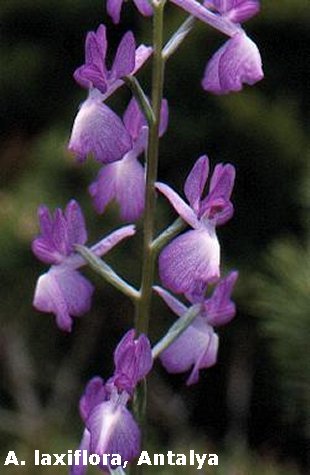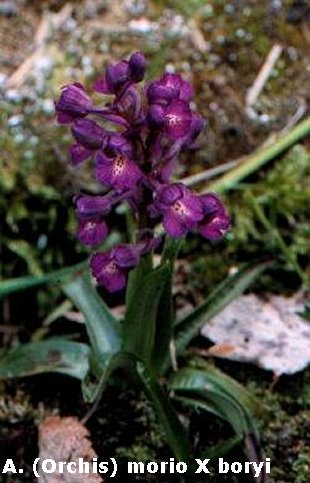|


Comments
to the offered plants:
Anacamptis (Orchis ) longicornu.
Very variable in its colouration, but unmistakable.
Frost hardy up to -7°C.
Anacamptis (Orchis ) champagneuxii.
Only known from France to Pertugal. Mainly in higher
evaluations. Slightly covered, the plants withstand the last winter
without being damaged by frosts.
Anacamptis (Orchis) hybrids with A. morio.
The green-winged Orchid inherits to its progeny a high degree
of frost hardiness. In flowershape the plants are intermediate between
the parents. In crosses with A. papilionacea, the Butterfly orchid
is the dominating parent. Hybrids of A. morio with A.longicornu
and A. papilionacea are very hardy.
(Anacamptis (Orchis) morio X A syriaca alba.
Most plants are tender rose flowered. Frost hardy.
Anacamptis (Orchis) laxiflora.
Anatolian plants are more robust and taller. Frost hardiness
of anatolian plants -12°C, of sardian plants -8°C. During
the last winter, the anatolian plants showed to be hardy, the sardian
plants were damaged by frosts.
|
Distribution:
As defined by Pridgeon et al. 1997, there are twenty species
in the genus. The distribution is euromediteranean, from Morocco
to Iran and the Caucasus, up to Norway in the north.
Description:
Flower stems 10 to 100cm high, with a rosette of leaves
or spaced out up the stem in the palustris/laxiflora-group. Anacamptis
has small to medium sized, numerous flowers. A spur is
always present on the labellum. The perianth segments spread or
form a hood. All species are insect pollinating.
Culture:
With the exception of A. pyramidalis, Anacamptis are fairly
easy in cultivation. All plants are summer dormant
and rest as tuberoids. Plants emerge in late summer, autumn or late
winter and flower in spring and early summer. Culture as sunny as
possible. Frost hardiness depends on the species.
Frost hardy up to -6°C (mediteranean species and races) or
up to -18°C (middle European species and races). Regular watering
during the growing period is essential for pot culture. Fertilize
monthly with 0.2g/l until flowering. Reduce watering with
the onset of flowers and stop as the leaves die back. Completely
dry during dormancy. In outdoor culture, summer rain is not
harmful if planted in a well draining soil. Occasionally a
light spray of water for small plants and seedlings to prevent dehydration.
If grown inside, move plants temporary outside in late summer
as cool nights and some rain will stimulate plants
into the new growing season.
Recommended potting mixes:
80% Seramis, fine to medium grade perlite, pumice or fine
expanded clay give good results. 20% organic components. Favourable
are fermented or N-impregnated wood shavings or saw dust.
(Toresa has given good results.) 20% peatbased mixes as TKS1 have
given even good results. Spagnum moss is not suitable.
Substrates have to be well draining with a pH of about 6.
Further reading:
Orchids of Britain & Europe. Pierre Delforge, 1995. Collins
Photo Guide. ISBN 0 00 2200244.
Orchideen im Garten: Verwendung, Pflege und Vermehrung. Gerd
Kohls und Ulrich Kähler, 1993.Parey, ISBN 3 489 636244.
Orchideen für den Garten: Europäische und tropische Erdorchideen.
Alfons Bürger, 1992. Ulmer, ISBN 3 8001 64876.
Das Moor im eigenen Garten: Moorgärten anlegen,gestalten
und pflegen. Erich Maier, 2000. Parey, ISBN 3 8263 3301 2
Hardy orchids. Phillip Cribb and Christopher Bailes, 1989.
Timber Pr. ISBN 0 88192 147 5.
Die Orchideen Mitteleuropas und der Alpen. Presser Helmut,
1995. ecomed, ISBN 3 609 65600 X.
|





